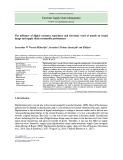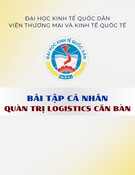
* Corresponding author
E-mail address: mihardjo@gmail.com (L. W. W. Mihardjo)
© 2019 by the authors; licensee Growing Science.
doi: 10.5267/j.uscm.2019.4.001
Uncertain Supply Chain Management 7 (2019) 691–702
Contents lists available at GrowingScience
Uncertain Supply Chain Management
homepage: www.GrowingScience.com/uscm
The influence of digital customer experience and electronic word of mouth on brand
image and supply chain sustainable performance
Leonardus W Wasono Mihardjoa*, Sasmokob, Firdaus Alamsjahb and Elidjenb
aDoctor of Research in Management Program, Business School, Bina Nusantara University, Jl. Hang Lekir I, No.6. Jakarta Pusat, Indonesia
bBusiness School, Bina Nusantara University, Jl. Kebon Jeruk Raya No.27, West Jakarta, Indonesia
C H R O N I C L E A B S T R A C T
Article history:
Received March 1, 2019
Received in revised format April
1, 2019
Accepted April 4 2019
Available online
April 5 2019
Digitalization plays a crucial role on current competitive market and it is associated with the
utilization of digital technologies to change business model and to deliver new value-producing
opportunities to the current business environment in an aim to move towards a digital business.
Therefore, to address new business model, the purpose of this study is to explore the effect of
digital customer experience and electronic word of mouth on sustainable performance of
supply chain through brand image and supply chain image. In this study, data is collected from
employees of Indonesian ICT companies. Clusters were formulated, and respondents were
selected randomly. Three hundred and fifteen (315) responses were analysed with the help of
structural equation modelling. The results indicate that digital customer experience and
electronic word of mouth played positive role on promoting brand image. Brand image had
positive role to promote supply chain image which influences positively on sustainable supply
chain performance. Therefore, this study is important for Information Communication and
Technology (ICT) industry to implement various e-commerce practices to promote digital
customer experience and electronic word of mouth.
., Canada
by
the authors; licensee Growin
g
Science2019 ©
Keywords:
Digitalization
e-commerce
Brand image
Supply chain
Sustainable performance
1. Introduction
Digitalization plays crucial role in the current competitive market (Leetaru, 2008). Most of the business
markets heavily depend on digitalization and it is one of the most essential elements of business market.
Digitalization is the utilization of digital technologies to change a business model and to deliver new
value-producing opportunities to the current business environment; it is also a procedure for moving
towards a digital business. Basically, it is the way of new innovation in business model. Introduction
of new technology for the sake of digitalization brings innovativeness to the business activities which
makes faster transections and physical transfer of goods. Therefore, it also has the effect on supply
chain activities. Generally, supply chain digitalization comes under electronic supply chain (e-supply
chain) (Poirier & Bauer, 2000). Digitalization facilitates supply chain activities of business (Castorena
et al., 2014; Dim & Ezeabasili, 2015; Wang & Lu, 2016; Vendrell-Herrero et al., 2017).





















